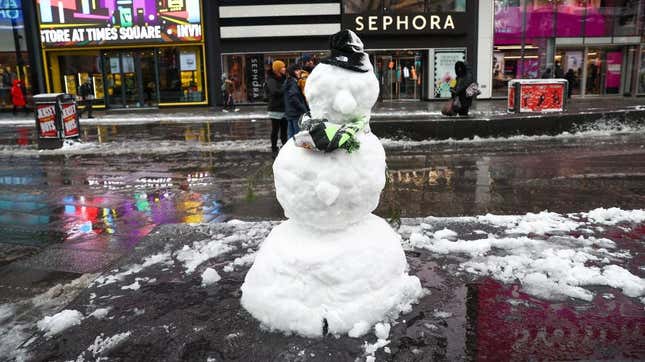
The New York City Tri-State area is in for a bomb cyclone this coming weekend. But how much snow the city and surrounding area will see is still up in the air. Big time.
The internet is currently littered with snowfall forecasts that range from 2 inches to 20 inches (5 to 50 centimeters) of snow, which means either minimal hassle or everything will shut down followed by a week of wallowing in gross, gray slush for the next week. The biggest uncertainty is around New York City itself, which is basically on the knife’s edge of the forecast.
The reason for the wildly divergent forecast has to do with how much data is available. Though meteorologists can start making predictions about a nor’easter a few days before, 24 to 48 hours before it reaches an area is usually when they’re able to give more accurate information about snowfall totals than “dusting to snowpocalypse.” And this forecast is proving to be particularly complex.
“There are a lot of different pieces of energy that are coming together to develop the storm,” said Nelson Vaz, a meteorologist with the National Weather Service’s New York office.
The main source of energy is a series of storms that will crash into the Pacific Northwest on Thursday. They will ride the jet stream across the U.S., take a turn down to the Southeast before emerging over the Atlantic near the Carolinas. There, the systems will spin up into one major storm that will wrap around a cold core, taking on a classic nor’easter comma shape as it rakes the Eastern Seaboard.
Importantly for the forecast, meteorologists are relying on models right now with few observations of the actual storms in question. Weather balloons and other types of observations launched over the coming days will give meteorologists more concrete data to feed into models and help refine the forecast itself, which is a mix of model information and human understanding of models and local conditions.
It is all but certain the nor’easter will intensify rapidly enough to be considered a bomb cyclone—that is, it will see its pressure drop at least 24 millibars in 24 hours—but the exact track is still very much a work in progress. The system still has a long journey across the country, and there’s a lot that could happen between now and then to the systems as well as areas of high and low pressure that will dictate how they combine and move up the East Coast.
A key metric to watch in the coming days is whether models show the storm pass over what’s known as the 40/70 benchmark. The 40/70 refers to latitude and longitude coordinates that tend to be a sweet spot for nor’easters to whip up waves and wind and drop copious precipitation.
Depending on if it passes there or closer or further to shore will have a huge impact on snowfall totals. New York is the epicenter of uncertainty on this front. Models simply don’t have enough data now to give a concise range, which is why there are so many different forecast totals out there. That’s why it’s more important than ever to pay attention to the forecast as it develops over the next 24 to 48 hours. And given how intense the system will be, paying attention to more than the snow totals is also vital.